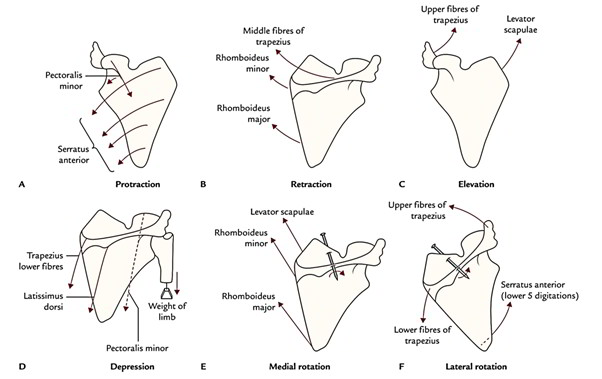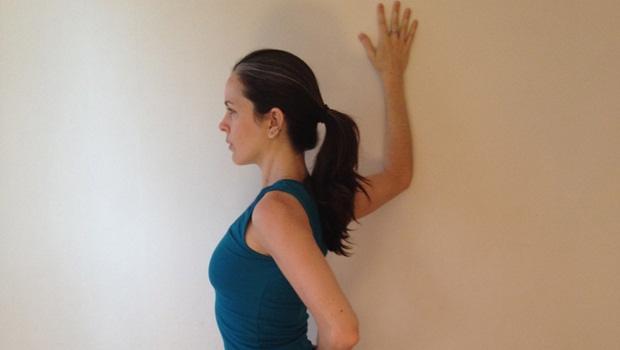Shoulders are often an unloved body area; we tend to take them for granted until something goes wrong. Common conditions such as frozen shoulder, aside from being painful, make everyday tasks like reaching, lifting, or dressing yourself very difficult. My philosophy is prevention is much better and easier than cure. Some regular mobilising, dynamic stretching, and strengthening of your shoulders will increase your overall body strength, decrease the load on your bones, ligaments and joints. In addition it will help you get more from any exercise that involves the upper body, be that tennis or weight lifting.
We have an amazing number of Shoulder Movements:
- Flexion
- Extension
- Abduction
- Adduction
- Horizontal Flexion
- Horizontal Extension
- Medial Rotation
- Lateral Rotation
- Circumduction
Tuning in to Your Shoulders
Let’s explore the right shoulder. Touch your clavicle (collar bone) and roll your shoulder; feel the movement of this bone. Place your fingers on the joint to the right of the hollow between your clavicles (collar bones), roll your shoulders again and feel the movement of this joint. Place your fingers on the end of your clavicle, close to your shoulder joint, move your arm up and down and notice how your clavicle follows.
Now place the back of your left hand on your right scapula (shoulder blade); if you can only just reach with your fingertips, that is fine. Lift and lower your arm and notice how the scapula rotates. This is natural movement and does not require excessive muscular action to perform.
Whilst you are here, please go ahead and explore some of the other movements listed above. Comparing the movements of your left side to your right side may also prove illuminating, particularly if you are right handed and participate in a one sided sport.
A little Anatomy for Understanding
The shoulder consists of the shoulder joint and the shoulder girdle.
The shoulder joint is a ball and socket joint between the scapula and the humerus. Like most synovial joints the articulating surfaces are covered with hyaline cartilage. As one of the most mobile joints in the body, the shoulder allows us to place our hand almost anywhere in space, but this mobility is achieved at the cost of stability. The head of the humerus is much larger than the glenoid cavity of the scapula; to reduce the disparity in surface areas, the glenoid cavity is deepened by a fibrocartilage rim, called the glenoid labrum.

The structures of the joint are enclosed in a fibrous sheath (the joint capsule), which extends from the neck of the humerus to the border of the glenoid fossa. The synovial membrane lines the inner surface of the joint capsule and produces synovial fluid to reduce friction between the articulating surfaces. To further reduce friction in the joint a number of fluid filled sacs (synovial bursae) act as cushions between tendons and other joint structures. In the shoulder joint, it is important to remember the ligaments play a key role in stabilising the bony structures.
The shoulder girdle is formed of 3 bones, the clavicle, the scapula and the humerus. The clavicle is an S-shaped bone situated at the front of your body in a horizontal position. It supports your shoulder, encourages a full range of motion, and protects your nerves and blood vessels that pass between the trunk of your body and your upper limbs. The clavicle provides the only direct connection between your shoulder girdle and axial skeleton. Unlike your clavicle, the scapula is located at the back of your shoulder. It is triangular in shape and connects your humerus with your clavicle. The scapula provides an attachment point for a number of muscles in your shoulder and upper limbs to your neck and back.
Flexibility vs Mobility
Flexibility and mobility are not the same, and it is important to understand the difference.

Flexibility refers to a muscle’s ability to lengthen.
Mobility is the ability of a joint to move through its full range of motion.
In my view both are important for the health of the shoulder, and to prevent injury.
What about Stability
Shoulder health, flexibility and mobility rely on scapula stability. Without this other muscles tighten up in order to try and achieve it. The scapula should be able to go through upward rotation, downward rotation, protraction, retraction, abduction, and posterior tilting.
 I often say shoulder problems are neck & thoracic spine problems, and those are breathing problems. If you have shoulder pain or limited mobility looking at the shoulder in isolation is rarely the answer. In my experience, shoulders cannot move if the thoracic spine is locked (upper traps get overworked and rhomboids become weak & overstretched), which leads to a stiff and painful neck. The whole scenario is usually compounded by limited breathing capacity.
I often say shoulder problems are neck & thoracic spine problems, and those are breathing problems. If you have shoulder pain or limited mobility looking at the shoulder in isolation is rarely the answer. In my experience, shoulders cannot move if the thoracic spine is locked (upper traps get overworked and rhomboids become weak & overstretched), which leads to a stiff and painful neck. The whole scenario is usually compounded by limited breathing capacity.
Posture, Posture, Posture
Everyday sitting, standing and sleeping posture has a huge effect on your shoulders. Just think of these chronic static postures as spending long periods in a static stretch or compression, and you can begin to imagine the effect on your muscles, ligaments, fascia and nervous system. In class we think holding a stretch for 5 minutes as a long time!
What about You?
Each person’s situation is different, but I believe everybody has the ability tune in to their body and make decisions according to its needs.
You probably know where you are tight – stretch that area. If that doesn’t improve your flexibility, ask yourself whether it is a strength issue? Highly likely it is a combination of both – you lack strength somewhere and other tissues are called upon to compensate.
Problems
- Arthritis – Both osteoarthritis (a degenerative disease that is very common in older adults) and rheumatoid arthritis (an autoimmune disease that causes inflammation, pain, and disfigurement of joints), can cause pain and loss of mobility in shoulder joints. That’s when scar tissue can lead to loss of joint motion.
- Soft Tissue Injuries – Labrum tears are common in people who perform overhead activities and sports. In my experience poor form and understanding of the shoulder in yoga, weight lifting, cross-fit, and intensive interval training can lead to rotator cuff tears.
- Dislocations, Separations and Fractures – Sustained trauma such as a fall can cause injury to the shoulder joint, resulting in a dislocation or separation – injury to the ligaments that hold the collar bone to the shoulder blade. Fractures of the humerus are common and can lead to stiffness. Scar tissue, another of the body’s responses to trauma, can impede motion.
- Bursitis – Inflammation of any of the six bursae in the shoulder often results from another underlying injury or impingement. Bursitis can cause significant pain and loss of range of motion in the affected joint.
The Way Forward
- Always warm up with proprioceptive work on your lats , spine and pecs
- Mobilise your thoracic spine
- Stretch your lats and serratus anterior
- Stabilise your scapulas with prone body weight exercises
- Focus & train the smaller muscles to support more load without unnecessary strain
- Challenge your shoulder on a regular basis by exploring its full range of motion
Exercises
You are familiar with the following exercises, I’m just highlighting them and their relevance to maintaining shoulder health. Most of us spend too much time in internal rotation (sitting, doing forward facing tasks). Try these exercises, then think of other exercises that you know that could be beneficial to stabilising your scapula, stretching your tight areas and improving your range of movement.







